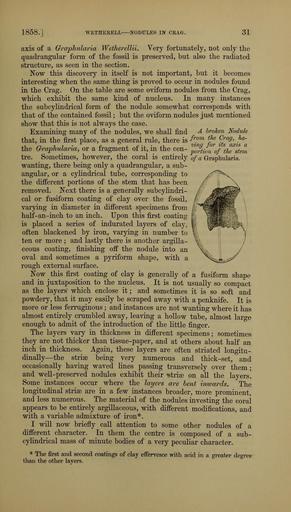MAKE A MEME
View Large Image

| View Original: | The_Quarterly_journal_of_the_Geological_Society_of_London_(12981326274).jpg (1162x2045) | |||
| Download: | Original | Medium | Small | Thumb |
| Courtesy of: | commons.wikimedia.org | More Like This | ||
| Keywords: The Quarterly journal of the Geological Society of London (12981326274).jpg 1858 WETHERELL NODTJLES IN CRAG 31 <br> axis of a Graphularia Wetherellii Very fortunately not only the <br> quadrangular form of the fossil is preserved but also the radiated <br> structure as seen in the section <br> Now this discovery in itself is not important but it becomes <br> interesting when the same thiQg is proved to occur in nodules found <br> in the Crag On the table are some oviform nodules from the Crag <br> which exhibit the same kind of nucleus In many instances <br> the subcylindrical form of the nodule somewhat corresponds with <br> that of the contained fossil ; but the oviform nodules just mentioned <br> show that this is not always the case <br> Examining many of the nodules we shall find broken Nodule <br> that in the first place as a general rule there is - t ' f ' -' <br> Vy 7 7' n j_ -i ˘ j_i vmq for tts axis a <br> the Graphularia or a fragment oi it in the cen- o 5/wi of the stem <br> tre Sometimes however the coral is entirely of a G-raphularia <br> wanting there being only a quadrangular a sub- <br> angular or a cylindrical tube corresponding to / s <br> the different portions of the stem that has been Z \ \ <br> removed Kext there is a generally subcylindri- fif/ I S <br> cal or fusiform coating of clay over the fossil f/ mSBl <br> varying in diameter in different specimens from / S i <br> half-an-inch to an inch Upon this first coating u HR' t <br> is placed a series of indurated layers of clay P ' <br> often blackened by iron varying in number to \\ – <br> ten or more ; and lastly there is another argilla- ' li / <br> ceous coating finishing off the nodule into an \s\ ;; / <br> oval and sometimes a pyriform shape with a L <br> rough external surface <br> Now this fiirst coating of clay is generally of a fusiform shape <br> and in juxtaposition to the nucleus It is not usually so compact <br> as the layers which enclose it; and sometimes it is so soft and <br> powdery that it may easily be scraped away with a penknife It is <br> more or less ferruginous ; and instances are not wanting where it has <br> almost entirely crumbled away leaving a hollow tube almost large <br> enough to admit of the introduction of the little finger <br> The layers vary in thickness in different specimens; sometimes <br> they are not thicker than tissue-paper and at others about half an <br> inch in thickness Again these layers are often striated longitu- <br> dinally ” the strias being very numerous and thick-set and <br> occasionally having waved lines passing transversely over them; <br> and well-preserved nodules exhibit their – striae on aU the layers <br> Some instances occur where the layers are lent inwards The <br> longitudinal striae are in a few instances broader more prominent <br> and less numerous The material of the nodules investing the coral <br> appears to be entirely argillaceous with different modifications and <br> with a variable admixture of iron <br> I will now briefly call attention to some other nodules of a <br> different character In them the centre is composed of a sub- <br> cylindrical mass of minute bodies of a very peculiar character <br> The first and second coatings of clay effervesce with acid in a greater degi'ee <br> than the other layers 36161568 111474 51125 Page 31 Text v 15 http //www biodiversitylibrary org/page/36161568 1859 Geological Society of London NameFound Graphularia NameConfirmed Graphularia NameBankID 4181713 Biodiversity Heritage Library The Quarterly journal of the Geological Society of London v 15 1859 Geology Periodicals Smithsonian Libraries bhl page 36161568 dc identifier http //biodiversitylibrary org/page/36161568 smithsonian libraries Information field Flickr posted date ISOdate 2014-03-07 Check categories 2015 August 26 CC-BY-2 0 BioDivLibrary https //flickr com/photos/61021753 N02/12981326274 2015-08-26 14 51 28 cc-by-2 0 PD-old-70-1923 The Quarterly journal of the Geological Society of London 1859 Photos uploaded from Flickr by Fæ using a script | ||||